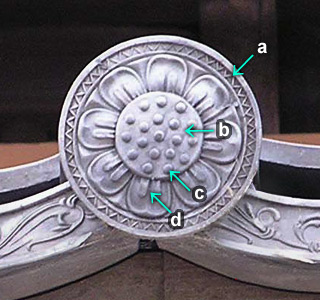|
||
 |
||

@
@
(C)2001 Japanese Architecture and Art Net Users System.@No reproduction or republication without written permission.
fΪΜeLXgEΚ^ECXgΘΗASΔΜRecΜ³f‘»E]ΪπΦΆά·B
|
||||||
| @ | ||||||
| fukuben rengemon@‘Ω@ΨΆ | ||||||
| KEY WORD :@architecture / roofing tiles | ||||||
| @ | ||||||
| Also written ‘Ω@ΤΆ. A double lotus petal motif applied to the pendant tiles *gatou ’, along the edge of the eaves of a tiled roof. The double petal motif is believed to have first appeared in the Hakuhou period. Usually eight petals are arranged around a center circular pod containing a varying number of raised seeds *chuubou [. Each double petal is divided by a line emanating from the outer rim of the pod. Each half of the petal contains a seedling leaf. Although a real lotus flower has sixteen petals, to arrange that number of petals on a pendant tile would look more like a chrysanthemum motif which did not appear until the 16c. Therefore, reducing the lotus motif to eight double petals produced an excellent stylized lotus pattern. This pattern remained popular for temples and palaces constructed through the late 12c. Examples of the pattern have been excavated at many sites including the Suufukuji site, Shiga prefecture, the Fujiwara ‘΄ palace site and the site of the Yamadadera Rc, both in Nara, the Heijou ½ι palace site , in Nara, and the Heian ½ΐ palace site, in Kyoto. | ||||||
| @ | ||||||
 @ |
||||||
@ |
||||||
| REFERENCES: | ||||||
| *soben rengemon fΩ@ΨΆ, *tanben rengemon PΩ@ΨΆ | ||||||
| EXTERNAL LINKS: | ||||||
| @@ | ||||||
| NOTES: | ||||||
| @ | ||||||
(C)2001 Japanese Architecture and Art Net Users System.@No reproduction or republication without written permission. fΪΜeLXgEΚ^ECXgΘΗASΔΜRecΜ³f‘»E]ΪπΦΆά·B |
||||||
| @ |